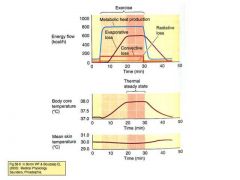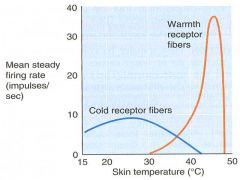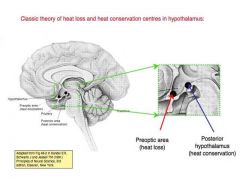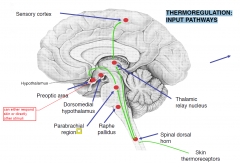![]()
![]()
![]()
Use LEFT and RIGHT arrow keys to navigate between flashcards;
Use UP and DOWN arrow keys to flip the card;
H to show hint;
A reads text to speech;
21 Cards in this Set
- Front
- Back
|
variation in body temperature
|
• Normal range: 36-38 C
• Fever or exercise: 38-40 C • Heat stroke: 40-44 • Mild hypothermia: 34-36 C • Severe hypothermia: 30-34 C • Cardiac fibrillation: 27-29 C |
|
|
Normal variation in body temperature
|
- circadian rhythm: amplitude of 1 degree. lowest
at 3-6 am, highest at 3-6 pm. It is due to actions of the autonomic nervous system, - menstrual cycle; usually increasing about 1 degree during the post-ovulatory phase. - • Infants are less able to maintain body temp – newborn babies do not readily shiver or sweat, and also have a high surface-mass ratio, so are more susceptible to changes in ambient temp. • Older people also have less effective regulation, due to a deficit in ability to sense temp changes, reduced ability to generate heat (reduced metabolic rate and skeletal muscle mass) and to dissipate heat (reduced cardiovascular reserve and sweat gland atrophy). |
|
|
variations in metabolic rate affecting heat production
|
• (1) voluntary and involuntary muscle activity;
• (2) Certain hormones, e.g. thyroxine and adrenaline, that increase cellular metabolic rate; • (3) a rise in tissue temperature itself can increase metabolic rate. • Under resting conditions, rate of heat production is approx. 80kcal/h. During a fast walk or jog this increases to 400-600kcal/h. • This extra thermal load would increase core temp. by 1 degree every 8-10 min if there were no compensatory heat loss response. • In practice, body temp. during exercise rises to a new steady state level, because increased heat loss matches increased heat production. |
|
|
Resting Muscle
|

|
|
|
Muscle during exercise
|
During exercise, muscle temp at first rises rapidly, and heat now flows from muscle to blood. Muscle blood flow increases greatly (why??) and rate of heat convected away therefore increases also. Core temp therefore rises. As exercise continues, muscle temp. reaches a new steady-level, and core temp also .
|
|
|
What prevents the body from over-heating?
|
Heat is transferred from the core to the skin, primarily by convection, i.e. by increased blood flow to the skin. Thus ability to increase or decrease skin blood flow is therefore the principal means to lose or conserve heat, respectively, in humans.
Some heat is also transferred from the body core by the evaporation of water from the respiratory tract, which is directly related to ventilation rate. This is a significant factor during exercise. In other animals, this is the principal means of heat loss (e.g. panting in dogs- most furry animals) |
|
|
Radiation
|
Heat is gained or lost by radiation at a rate that is proportional to the temperature Difference between the skin and the radiating body, and the surface area of the exposed skin. In a neutral thermal environment (I.e. ambient temp of 20-25 degrees, low humidity, no wind) approx. 60% of heat loss at rest is by radiation.
|
|
|
Conduction
|
Only significant when skin is in contact with a conducting surface (e.g. ice, ground).
|
|
|
Convection
|
This occurs when heat is carried by air or water from the skin. The rate of convective
heat loss is determined by the following equation: The convective heat transfer coefficient is highly variable, & can increase up to 5 times as wind velocity increases (“wind chill factor”). When immersed in water, it is about 100 times higher than in air - hence hypothermia occurs much more rapidly during water immersion |
|
|
Evaporation
|
Humans can dissipate nearly all heat produced by evaporating sweat. The evaporative rate is independent of the temperature gradient between skin and air, and depends only on the water vapour pressure gradient, as follows:
Sweat glands can deliver up to 30 mL of fluid per min to skin. Since evaporation of 1 mL of water removes appproximately 0.6 kcal of heat, maximum heat loss is 18 kcal per min, I.e. approx 1000 kcal per hr, equal to amount of heat generated by heavy exercise in that time. Air movement increases the water vapour pressure difference between the skin and air. This also explains the importance of humidity as a factor in affecting heat loss in hot conditions. |
|
|
Physiological factors that limit the effectiveness of
evaporative heat loss |
• Dehydration (reduces ability to produce sweat)
• Any factor that reduces the ability to increase cardiac output (e.g. hypovolaemia, heart failure) • A reduced ability to redistribute cardiac output to the skin (e.g. autonomic incapacity) |
|
|
Blood Shifts in heat
|
in heat stress there is an inhiition of SN innervating arterioles (dilates) and so INC. SN to kidney and gut (thus dec. blood flow to gut but INC. skin blood flow by 20-30times.
|
|
|
Heat production and loss in Exercise
|

|
|
|
Firing rates of cold and warmth receptors
|

warm receptors dramatically increase their firing
|
|
|
Heat loss and conservation centres
|

thermoregulation in the hypothalamus (theory, 2 centres in the hypothalamus, preoptic (anterior area, the heat loss centre), triggers a heat loss response (sweating..)
Posterior hypothalamus; heat conservation (shivering, vasoconstriction, piloerection) |
|
|
Efferent mechanisms: current view
|

brown adipose: rats rely on this to produce heat
|
|
|
Brown adipose tissue
|

|
|
|
THERMOREGULATION:
OUTPUT PATHWAYS |

|
|
|
THERMOREGULATION:
INPUT PATHWAYS |

thermoreceptors in the core and at the peripheries (skn)
|
|
|
Medulla oblongata centres
|

|
|
|
Fever MOA
|

|

